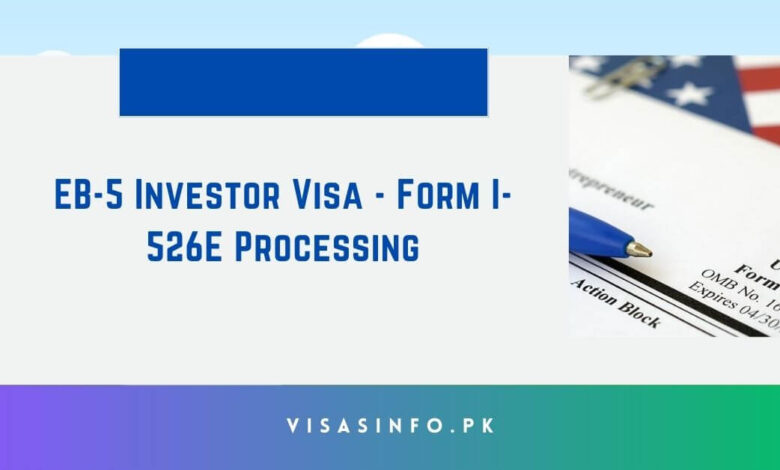EB-5 Investor Visa – Form I-526E Processing

Before 2024, there are five new items to be aware of about EB-5 Immigrant Investor Visas. In the past month, there has been a significant amount of activity in the EB-5 program. Information regarding visa processing and US Citizenship and Immigration Services (USCIS) is available from the US Department of State. These are five novel perspectives on EB-5.
Duration of Support
Guidelines issued by the United States Citizenship and Immigration Services (USCIS) explain the EB-5 Reform and Integrity Act (RIA) of 2022. The RIA is the sustainment period for investors who submit the new form I-526E after the RIA. After the entire amount of the qualifying investment is transferred to the new commercial enterprise and is placed at risk under all relevant conditions, such as being made available for the work, only two years must elapse. This is the time during which the investment capital of EB-5 must be considered at risk.
It is logical to establish an entity. This could potentially have a substantial effect on the EB-5 market, as it appears that USCIS is no longer mandating that investors maintain their investment for the duration of the conditional residence period. The sustainment period continues to be the first two years of conditional residency for pre-investors.
This information may be beneficial to certain investors; however, the primary concern of numerous investors is the anticipated return of their funds. This is addressed by the subscription or contract, not the USCIS guidance, which pertains exclusively to the Green Card application process.
Wastage of EB-5 Visas
The Department of State (DOS) reported in FY 2023 that the total number of unreserved visa numbers issued in FY 2023 was likely to exceed the yearly limit of 9,500. The majority of these visas were issued by foreign embassies, while an additional 1,500 were utilized through USCIS adjustment of status applications.
Check Also: Australia Upcoming Visa Changes
Processing of I-526E at a faster pace
USCIS appears to have distinct adjudication teams that are processing applications more rapidly for post-reform I-526s. Our company has received Form I-526E approvals for investments in specific rural projects in as little as three months. However, multiple regional centers have reported that USCIS is approving Form I-526s for investments in their high unemployment area projects in approximately twelve to thirteen months.
It was explicitly stated by USCIS that the regional center’s form I-956F project template must be approved before the form I-526E submitted by a single investor in the project is considered. Potential investors are progressively seeking information regarding form I-956F adjudications from regional centers before making an investment decision.
Benefits of EB-5 Investor Visa – Form I-526E Processing
- Path to Permanent Residency: Successful petitioners and their immediate family members (spouse and children under 21) can obtain U.S. green cards, which will grant them permanent residency.
- Investment Opportunities: By investing in a diverse array of U.S. businesses and industries, investors have the potential to generate a return on their investment.
- In contrast to employment-based visas, the EB-5 visa does not require a job offer or employer sponsorship.
- Family Benefits: The investor’s immediate family members are also granted green cards, which allow them to continue to reside, work, and study in the United States.
- Citizenship Pathway: After obtaining a green card for five years, holders of an EB-5 visa are eligible to petition for U.S. citizenship.
- Opportunities for Education: In several states, green card holders are eligible for in-state tuition rates and have access to U.S. educational institutions.
- Flexibility in Travel: Permanent residents are subject to fewer restrictions when traveling in and out of the United States than non-immigrant visa holders..
The number of EB-5 visas issued in the fiscal year reached a record high.
More EB-5 visas than ever before will be available for use in FY 2024. An estimated 20,000 investor green cards will be generated by the Visa carryover Provisions in the RIA. Reserved visas from FY 2022 were not utilized in FY 2022 or FY 2023 and are now allocated to the unreserved FY 2024 as a result of delayed adjudications. Similarly, reserved visas from FY 2023 were not utilized in FY 2023 and are now allocated to the reserved FY 2024.
In general, the EB-5 outlook for FY 2024 is quite optimistic, and we assume that the reserved Visa categories will remain current in the Visa Bulletin for the next six months, if not the entire year. Instead of postponing Green Card appointments until the final months of the fiscal year, numerous US consulates should expedite the process of scheduling interviews and issuing immigrant visas throughout the fiscal year.
Relief for Pre-RIA Investors in Regional Centers Terminated Due to “Administrative Noncompliance”
It appears that the USCIS’s most recent guidelines are providing some relief to certain pre-RIA investors who invested in projects associated with regional centers and no longer wish to be recognized under the explicit rules of RIA. Despite the termination of their Associated Regional Center, USCIS notes that pre-RIA investors may still be eligible for green cards in certain circumstances due to the indirect jobs that were created about their petition before the RIA was enacted. However, the exact definition of purely administrative non-compliance remains unclear.
The purpose of this guidance is to safeguard immigrant investors if USCIS intends to terminate Regional centers that neglect to submit the appropriate form I-956G or pay the mandatory EB-5 Integrity fee this year. Although the practical application of this remains uncertain, it provides some investors with a sense of optimism if their regional centers are closed.
Treatment of Pre-RIA Investors in Regional Centers That Have Been Terminated
The RIA incorporated a clause that enables specific investors associated with closed Regional centers to remain eligible for conditional permanent residency under the EB-5 program. The new guidance explicitly states that the RIA applies to qualifying pre-RIA investors.
In instances where the USCIS determines that the investment and ensuing job creation are not impactful, the case may still be approved, even if a regional center is terminated for administrative noncompliance. The guideline underscores the USCIS’s commitment to ensuring that the RIA’s necessary modifications are implemented in a manner that is most beneficial to investors, while simultaneously adhering to the program’s integrity and legal obligations. It provides investors with increased clarity and autonomy as they navigate the EB-5 program in the post-RIA era.
Frequently Asked Questions:
-
What’s the processing time for 526E?
The average processing time for I-526 petitions decreased from 19 months in FY 2019 to 12.6 months in the first quarter of FY 2020, according to the USCIS report, which initially pleased the EB-5 industry and investors.
-
What is the processing time for an I-526 direct investment?
Also, the EB-5 Reform and Integrity Act 2021 will not only reauthorize the program for five years but mandate that USCIS charges the fees necessary to ensure an average of four months to process a Form I-526 with a Targeted Employment Area (TEA) investment and eight months for a standard investment.
-
How long does it take to get EB-5 visa approval?
You should receive an EB5 visa within about a week after completing the interview. This process takes about 6 to 8 months. Upon approval of your status adjustment or entry into the country with a valid EB5 visa, you become an official conditional permanent resident for 2 years.



